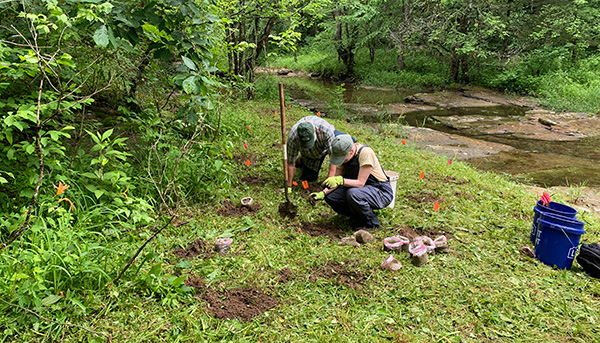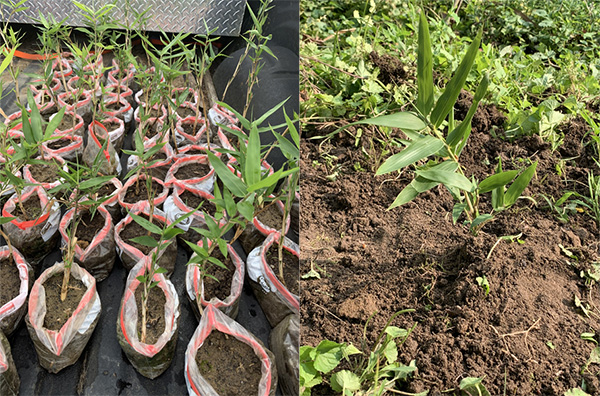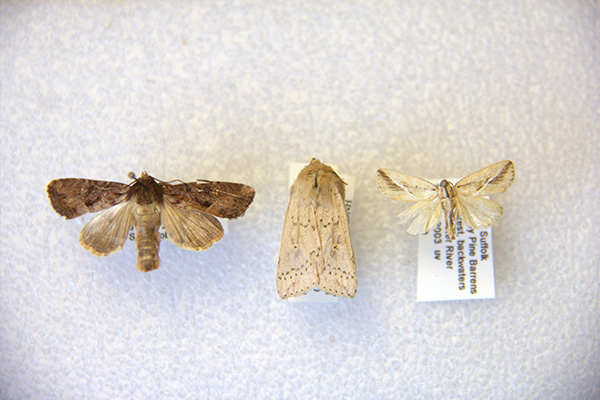
 Department of Conservation and Recreation
Department of Conservation and Recreation
Conserve. Protect. Enjoy.
 Department of Conservation and Recreation
Department of Conservation and Recreation
By Emi EndoPosted March 26, 2024
If you drive around Southwest Virginia, you'll see roads named “Caney Creek Road” or “Cane Valley Road.” These names suggest that stands of native river cane (Arundinaria gigantea) once made their presence known on both sides of the Powell River, extending up every tributary and valley in the area.
Because of fire exclusion, widespread cattle grazing and land development, river cane — a species with cultural and historical significance in the Southeastern United States — today occupies only about 2% of its native range.

But for the fourth year in a row, stewards and volunteers are cultivating and planting river cane where it previously flourished.
River cane stands, or canebrakes, help to control erosion along streambeds, improve water quality and deter invasive species. Canebrakes support habitat for migratory songbirds and other wildlife.
In 2021, Laura Young, Southwest region steward in the Virginia Natural Heritage Program, launched a pilot program to restore canebrakes along unvegetated riverbanks in The Cedars Natural Area Preserve in Lee County. The plants successfully took root.
Staff and volunteers were able to propagate new plants by harvesting rhizomes (underground stems) divided from the original plants in the spring and cultivating them in sandwich bags on their porches until they were ready to plant.

“It’s so amazing to see that with a small number of volunteers and very few dollars we have been able to start four new anchors of cane with about 200 individual plants along waterways in The Cedars Natural Area Preserve,” Young said. “Watching these plants transition from individuals to small canebrakes over the last three years has driven home the power of grassroots restoration work.”
Last year, the volunteers added an additional cane anchor to Wallen’s Creek, which is experiencing extreme erosion, and an anchor on the North Fork of the Holston.
River cane plants, a type of North American, temperate bamboo species, serve as host plants to rare moths whose larvae rely on them for food.

1) Protapamea danieli (Daniel’s cane borer; not ranked globally, state rare GNR S1S3) 2) Leucania calidior (cane wainscot; globally and state rare G2G4 S1S3) 3) Argillophora furcilla (silver fork cane moth; globally and state rare G3G4 S1S3)
Four such cane feeding moth species, including cane wainscot (Leucania calidior) and silver fork cane moth (Argillophora furcilla), have been documented at The Cedars, according to Steve Roble, zoologist in the Virginia Natural Heritage Program.
Young said river cane is well adapted to live along waterways that flood regularly since it can withstand inundation for short periods of time and its flexible culms (stems) allow it to flow and bend with the river when it is underwater. The extensive root systems of these canebrakes are great at trapping sediment that’s being carried in the river and the large plants are successful in shading out many types of invasive species that are easily transported by rivers.
Partners in this restoration effort include The Nature Conservancy in Virginia, the Friends of The Cedars volunteer group, Virginia State Parks and University of Virginia’s College at Wise.
“At this point, we’ve shown that cane restoration is possible in our area with limited resources, and we are super excited that all our partners and several localities are interested in helping us scale up our efforts in 2024,” Young said.
“If we can just get native river cane started across the landscape,” she added, “it will slowly grow and recover what used to be its native domain.”
For information on river cane restoration volunteer opportunities, visit The Nature Conservancy Eventbrite page, or email Laura Young at laura.young@dcr.virginia.gov or Nick Proctor at nick.proctor@tnc.org.
Categories
Conservation | Native Plants | Natural Heritage
Tags
native plants

